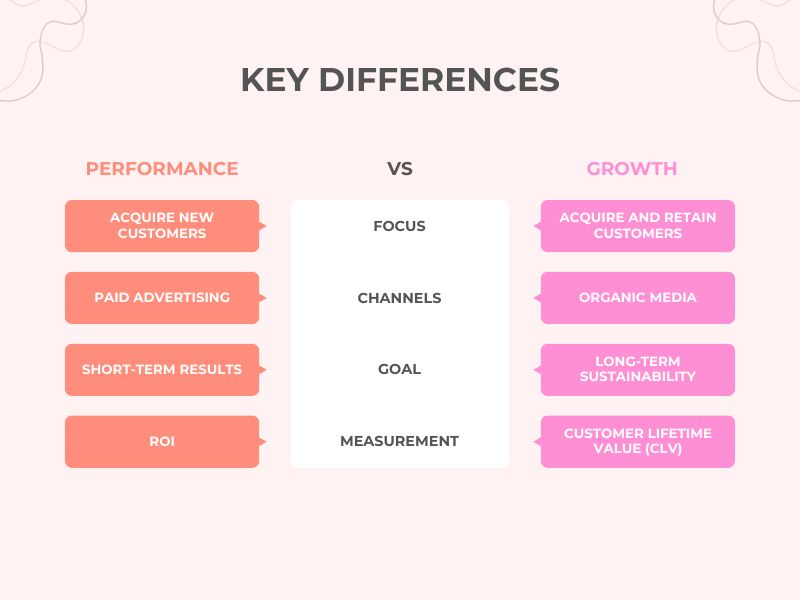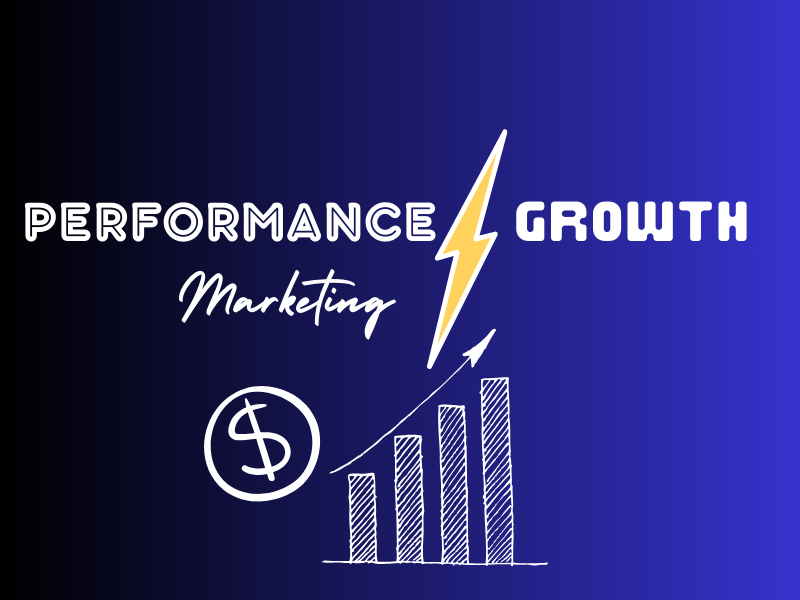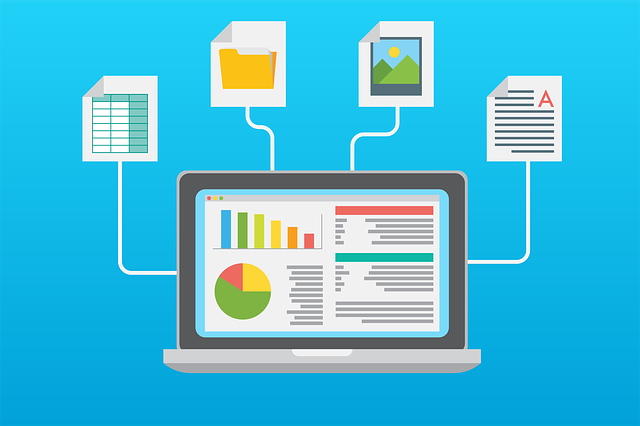Are you looking to drive success and growth for your business in the digital landscape? If so, then you have to find the right balance of performance marketing vs growth marketing.
These two strategies are often used interchangeably, but they actually have distinct differences that can greatly impact your marketing efforts.
Finding the right balance of performance marketing vs growth marketing is crucial for achieving overall marketing success. While performance marketing can bring immediate results, neglecting long-term growth strategies can lead to stagnation. Conversely, focusing solely on growth marketing can lead to slow progress and missed opportunities.
I am Patrizia, I am a marketer with 10 years of experience, and in this article, I will explore all the relevant aspects of performance vs growth marketing, and how finding the right balance between the two can drive success for your business in the digital age.
So, let’s dive in and uncover the key strategies that will help you stay ahead in today’s competitive marketplace.
What’s the difference between Performance marketing and growth marketing
Performance marketing: Deep Dive
Performance marketing vs growth marketing: What’s the right balance?
Key metrics to measure success in performance marketing
Key metrics to measure success in growth marketing
Strategies for performance marketing vs growth marketing
Conclusion: Performance marketing vs growth marketing
What’s the difference between Performance marketing and growth marketing?
The main difference between performance marketing and growth marketing is the focus. Performance marketing is focused on short-term results, while growth marketing is focused on long-term sustainability. Performance marketing is also more focused on paid advertising, while growth marketing uses a variety of channels.
Here is a table summarizing the key differences between performance marketing and growth marketing:

Now let’s go into the details and get an understanding of the details of performance marketing vs growth marketing.
Performance marketing: Deep Dive
Performance marketing is a short-term approach that focuses on driving immediate results and measurable actions, such as conversions, sales, and cost-per-acquisition.
It is a data-driven approach that relies heavily on analytics and optimization to maximize ROI.
This strategy involves paid advertising channels like Google Ads, Facebook Ads, and affiliate marketing. The main goal of performance marketing is to generate a positive return on investment (ROI) and achieve specific key performance indicators (KPIs).
Where you should use performance marketing:
In short, to drive conversions.
1. Launching a new product or service:
Performance marketing can be used to launch a new product or service by generating awareness and interest among potential customers. This can be done through paid advertising, social media marketing, and other channels.
Example
A new clothing brand might use performance marketing to launch its first collection by running paid advertising campaigns on social media and search engines. The ads would target people who are interested in fashion and who are likely to be interested in the brand’s products.
2. Running a seasonal promotion:
Performance marketing can also be used to run a seasonal promotion by driving traffic to your website or landing pages. This can be done through paid advertising, search engine marketing, and other channels.
Example
A coffee shop might use performance marketing to run a seasonal promotion by running paid advertising campaigns on social media and search engines. The ads would target people who are interested in coffee and who are likely to be interested in the coffee shop’s promotion.
3. Targeting a specific audience:
Performance marketing can be used to target a specific audience with your marketing messages. This can be done by using demographics, interests, and other factors to segment your audience.
Example
A financial advisor might use performance marketing to target a specific audience of high-net-worth individuals by running paid advertising campaigns on LinkedIn and other professional networking sites. The ads would target people who have the income and assets that the financial advisor is looking for.
4. Reaching a specific goal:
Performance marketing can be used to reach a specific goal, such as increasing website traffic, generating leads, or driving sales. This can be done by tracking your results and making adjustments to your campaigns as needed.
Example
A SaaS company might use performance marketing to reach a specific goal of generating 100 leads per month by running paid advertising campaigns on Google Ads and Facebook Ads. The company would track the results of the campaigns to make sure that they are reaching their goal.
Growth Marketing: Deep dive
On the other hand, growth marketing is a long-term approach that takes a more holistic view, aiming to foster sustainable growth by focusing on user retention and lifetime value.
It involves strategies such as content marketing, search engine optimization (SEO), email marketing, and social media engagement. Growth marketing is centered around building relationships with customers, improving brand awareness, and driving organic growth over time.
Where you should use growth marketing:
In short, to create a relationship with your leads or customers.
1. Nurturing leads
Growth marketing can be used to nurture leads by providing them with valuable content and resources that help them learn more about your products or services. This can help you to build trust and credibility with potential customers and increase the chances that they will convert into paying customers.
Example
A company that sells online courses could create a blog that provides helpful content on topics related to the courses they offer. This would help to attract potential leads and educate them about the company’s products or services.
2. Engaging with customers
Growth marketing can also be used to engage with customers after they have made a purchase. This can be done through email marketing, social media marketing, and other channels. By engaging with customers, you can build loyalty and encourage them to make repeat purchases.
Example
A clothing retailer could send out a monthly email newsletter to its customers with new arrivals, special offers, and styling tips. This would help to keep customers engaged with the brand and encourage them to make repeat purchases.
3. Upselling and cross-selling
Growth marketing can also be used to upsell and cross-sell to existing customers. This can be done by offering discounts, promotions, and other incentives to encourage customers to buy more from you.
Example
A furniture store could offer a discount on a new sofa to customers who also purchase a coffee table. This would help to increase the average order value and boost sales.
4. Reactivating dormant customers
Growth marketing can also be used to reactivate dormant customers. This can be done by sending them abandoned cart emails, birthday emails, or other targeted messages. By reactivating dormant customers, you can recover lost revenue and increase your customer lifetime value.
Example
A subscription service could send out an email to customers who have not used their service in a while with a special offer to entice them to come back. This would help to recover lost revenue and increase customer lifetime value.
The benefits of performance marketing
Performance marketing offers several benefits that make it an attractive strategy for businesses looking for immediate results. One of the key advantages is its highly measurable nature. With performance marketing, you can track and analyze the performance of your campaigns in real time, allowing you to make data-driven decisions and optimize your marketing efforts for maximum results.
Another benefit of performance marketing is its ability to deliver targeted and personalized messages to specific audiences. By leveraging data and targeting options available on platforms like Facebook and Google, you can ensure that your ads are reaching the right people at the right time, increasing the chances of conversions and sales.
Additionally, performance marketing allows for scalability. You have the flexibility to increase or decrease your marketing budget based on the performance of your campaigns. This means that you can invest more in the channels that are delivering the best results and adjust your strategy accordingly.
The benefits of growth marketing
While performance marketing focuses on short-term results, growth marketing takes a more long-term approach. One of the key benefits of growth marketing is its focus on building lasting relationships with customers. By providing value through educational content, engaging social media presence, and personalized experiences, growth marketing aims to create loyal customers who will continue to support your brand.
Another advantage of growth marketing is its emphasis on organic growth. By investing in strategies like content marketing and SEO, you can increase your brand’s visibility in search engine results and attract organic traffic to your website. This not only helps in driving conversions but also reduces your reliance on paid advertising channels, resulting in cost savings in the long run.
Furthermore, growth marketing allows for continuous improvement and optimization. By constantly analyzing data, conducting experiments, and listening to customer feedback, you can refine your marketing strategies and adapt to changing consumer behavior. This iterative approach ensures that your marketing efforts remain effective and relevant in the ever-evolving digital landscape.
Performance marketing vs growth marketing: What’s the right balance?
Finding the right balance for performance marketing vs growth marketing is crucial for achieving overall marketing success. While performance marketing can bring immediate results, neglecting long-term growth strategies can lead to stagnation. Conversely, focusing solely on growth marketing can lead to slow progress and missed opportunities.
Pro Tip:
The best approach is to use both growth and performance marketing together. This will help you to achieve your short-term and long-term marketing goals.
For example, you could use performance marketing to acquire new customers through paid advertising, and then use growth marketing to nurture those customers and turn them into repeat buyers.
To strike the right balance, it is important to align your goals and objectives with both performance and growth marketing strategies. Start by clearly defining your short-term and long-term objectives.
Identify the KPIs that are critical for measuring the success of your performance marketing efforts, such as click-through rates, conversion rates, and return on ad spend.
Simultaneously, establish metrics for measuring the impact of your growth marketing initiatives, such as website traffic, engagement rates, and customer lifetime value.
Once you have a clear understanding of your goals, you can allocate your resources and budget accordingly. Consider investing in both paid advertising channels for immediate results and organic growth strategies for long-term sustainability.
This could mean running targeted ad campaigns while simultaneously creating high-quality content, optimizing your website for search engines, and engaging with your audience on social media.
Pro Tip:
In my experience, I have seen brands allocate around 30% of their marketing budgets to performance marketing and the remaining 70% to growth marketing. The goal is to create a compounding effect with growth marketing, which will eventually allow you to become less reliant on performance marketing.
An essential step to maximize your business’ growth is to measure the results of performance marketing vs growth marketing. Check out the next section.
Key metrics to measure success in performance marketing
When it comes to performance marketing, there are several key metrics that you should track to measure the success of your campaigns. Depending on what’s performing best you may allocate more time and resources to performance or growth marketing. I’ll tell you a secret: Marketing is all about testing.
These are the metrics you should take into consideration:
1. Click-through Rate (CTR)
The percentage of people who click on your ads after seeing them. A high CTR indicates that your ads are relevant and compelling to your target audience.
2. Conversion Rate
The percentage of people who take a desired action, such as making a purchase or filling out a form, after clicking on your ads. A high conversion rate indicates that your ads are effectively driving action.
3. Return on Ad Spend (ROAS)
The revenue generated for every dollar spent on advertising. A high ROAS indicates that your advertising campaigns are profitable.
4. Cost per Acquisition (CPA)
The average cost of acquiring a new customer. A lower CPA indicates that your campaigns are efficient in acquiring new customers.
Key metrics to measure success in growth marketing
In growth marketing, there are different metrics that you should focus on to measure the success of your initiatives. These include:
1. Website Traffic
The number of visitors to your website. Increasing website traffic indicates that your content and SEO efforts are driving visibility and attracting users.
2. Engagement Rate
The level of interaction and participation from your audience, such as comments, shares, and likes on social media. A high engagement rate indicates that your content is resonating with your audience.
3. Customer Lifetime Value (CLTV)
The total worth of a customer over the entire duration of their relationship with your brand. A higher CLTV indicates that your marketing efforts are effectively nurturing and retaining customers.
4. Net Promoter Score (NPS)
A measure of customer loyalty and satisfaction. A high NPS indicates that your customers are likely to recommend your brand to others, leading to organic growth.
Strategies for performance marketing vs growth marketing
To achieve the right balance for performance vs growth marketing, consider implementing the following strategies:
1. Align Your Messaging
Ensure that your messaging is consistent across all channels. Your performance marketing campaigns should reflect the same brand values and positioning as your growth marketing initiatives.
2. Leverage Data
Use data from your performance marketing campaigns to inform your growth marketing strategies. Analyze customer behavior, preferences, and demographics to create targeted content and personalized experiences.
3. Optimize Landing Pages
Create dedicated landing pages for your performance marketing campaigns that align with your growth marketing objectives. Optimize these pages for conversions and provide valuable content to encourage further engagement.
4. Nurture Leads
Implement lead nurturing strategies to build relationships with potential customers who have shown interest through your performance marketing campaigns. Use email marketing and personalized content to guide them through the buyer’s journey.
5. Test and Iterate
Continuously test and iterate your marketing strategies based on data and customer feedback. Experiment with different messaging, creative, and targeting options to optimize your performance marketing campaigns while keeping an eye on long-term growth.
Conclusion: Performance marketing vs growth marketing
In today’s competitive marketplace, finding the right balance of performance marketing vs growth marketing is essential for driving success and growth for your business. While performance marketing delivers immediate results, growth marketing focuses on long-term sustainability and building lasting relationships with customers.
By integrating both strategies and aligning your goals, you can create a comprehensive marketing approach that maximizes short-term ROI while fostering long-term growth. Continuously analyze data, measure key metrics, and optimize your campaigns to ensure that your marketing efforts remain effective and relevant in the ever-changing digital landscape.
Remember, it’s not about choosing one strategy over the other, but about finding the right balance that suits your business objectives. So, embrace the power of performance marketing and growth marketing and unlock the full potential of your marketing efforts in the digital age.
Did I miss any important points about performance vs growth marketing? Let me know in the comments!
You may be interested in this article about why performance marketing is not enough to fuel a brand’s growth.




Pingback: Growth Marketing vs Demand Generation: Difference+Similarity